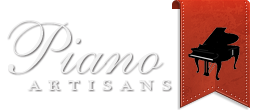The Foundation of the Duo-Art
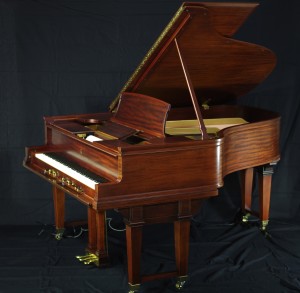
1915 Duo-Art, Steinway & Sons Model “AR”, Mahogany Veneer
Aeolian Duo-Art Information
The Aeolian Company was a relatively late entrant to the world of reproducing pianos, bringing the Duo-Art before the musical public in March 1914. By that time the Welte-Mignon had been selling their Reproducers for nine years, and various American manufacturers had already stepped into the market, such as the American Piano Company, with its Stoddard-Ampico system, which is reputed to have been launched in 1911.
There would seem to be two reasons for this uncharacteristic tardiness on the part of Aeolian Duo-Art Information. First is Aeolian’s unsuccessful attempt to produce a synchronized phonograph and player piano, which occupied the Aeolian experimental department for many years, and an apparent belief that most music-lovers wanted to create their interpretations on the pianola, rather than to listen passively to the performances of the great masters. Aeolian sought to emphasize the triple reproducing nature of its new instrument, allowing for automatic performance, personal control of standard rolls, and the direct playing of the piano by hand. Such an instrument might more aptly have been called a Trio-Art, whereas the name Duo-Art information would have ideally suited a combined phonograph and player piano.
Musical Example Below: This is our very own 1925 Steinway & Sons, Duo-Art, Model OR, playing Steinway DuoArt, This example was recorded by a young Sergei Prokofiev, Playing Rimsky-Korsakov Scheherazade, Fantasia Arrangement “Suite Symphonique”. Scheherazade
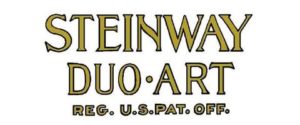
Actual Steinway Duo-Art Decal from the early 1920’s
This was the case with the Ampico for most of its existence, the Duo-Art recording machine did not record the pianist’s dynamics automatically, and so the skill and experience of the musical editors was paramount in determining how faithful a particular piano roll might be. It’s sometimes said that the highly edited Duo-Art Information rolls are more akin to portraits than to photographs, but a portrait can often be the more telling of the two.
Mechanical Aspect of the Aeolian Duo-Art
Aeolian Duo-Art Information about Mechanical Operation
Like the Themodist Pianola, the Duo-Art divided its playing mechanism into two halves, although the border from bass to treble occurred between Eb and E above middle C, one note lower than on most other systems. The reasons for this difference were not documented at the time but may have been influenced by the phonograph/player piano project mentioned above, which adopted an 85-note keyboard as the standard, leaving the top three note tracks on a regular 88-note roll to be used for synchronization purposes. The center of such a piano would fit more closely with the Duo-Art division.
In all standard reproducing pianos, an electric suction pump powers the playing mechanism and supplies a sufficient level of suction for the maximum loudness needed by the piano. Proprietary dynamic control devices reduce this suction level in various sophisticated ways so that a wide variety of dynamic effects is possible. In the diagram below, air is evacuated from the Duo-Art playing mechanism (the pneumatic stack) through a pipe on the left, passing through various windways inside the expression box, and thence to an electric suction pump with the aid of the pipe at the top of the diagram. The layout below is not necessarily representative of an actual Duo-Art installation.
Part of the Dynamic Control Mechanism of the Duo-Art.
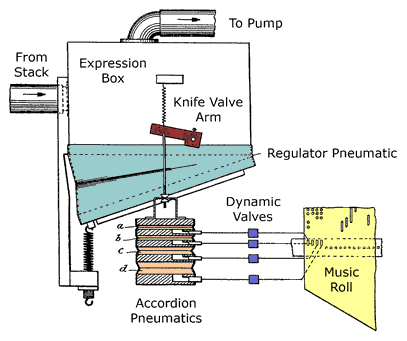
Aeolian Duo-Art Reproducing Mechanism Diagram
At the right, a perforated music roll passes over a tracker bar, which has holes in it connected via many small tubes to the individual note mechanisms of the instrument. At the left-hand edge of the music roll (and also at the right-hand, which is not shown), there are four special perforation positions which do not operate notes. Instead, they allow atmospheric air to pass through elongated tracker bar holes, operating the valves to control one of two accordion pneumatics, as Aeolian called them.
Each accordion has four separate sections, which progressively double in span, from top to bottom. Thus, Duo-Art power 1, which is operated by the outermost dynamic coding perforation on the roll, causes the top section of the accordion to collapse, moving the left-hand end of the knife valve arm by 1/16th of an inch. Powers 2, 4 and 8, operated by adjacent perforations on the roll, collapse by 1/8th, 1/4 and 1/2 of an inch respectively. The animation shows each section of the accordion working in succession, but in practice, the four dynamic coding perforations on the roll can be combined, allowing for sixteen degrees of dynamic control.
The Accordion Pneumatic pulls on a small wooden arm which is connected, via a rotating rod, to one end of a knife valve inside the expression box. This valve slides over a port (usually a round hole in the case of the Duo-Art), and as it opens the port, it allows suction from the pump to enter the large regulator pneumatic. The pneumatic closes in opposition to a coil spring, and, utilizing a rod attached to
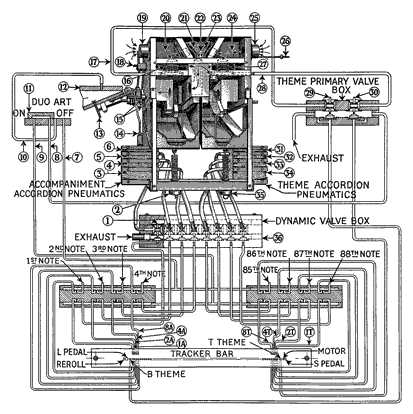
Aeolian Duo-Art Original Tubing Diagram
its inner surface, moves the other end of the knife valve until it also closes. Thus a state of equilibrium is reached, with the suction applied to the stack dependent mainly on the force exerted by the regulator spring, and also to some degree on the maximum level supplied by the pump.
This binary to analog decoding was central to the Aeolian Duo-Art Information, and in combination with separate Theme and Accompaniment regulators, switched by Themodist style perforations at the edges of the rolls, it had the potential for creating 32 different theoretical dynamic levels. In practice, since reproducing pianos do not operate at anything like the speed of computer systems, the 32 powers were more like miniature crescendos and decrescendos, in many cases dependent on the length of the perforations which operated them, and so the actual subtlety of dynamic shading was far greater than the theory might suggest. Besides, the response of the Duo-Art to its dynamic coding is modified by the number of notes being played, and even by any notes already played but held on by perforations that are still open. One should always remember that Duo-Art rolls were without exception edited on the pianos of the time, until they sounded right to the pianists and editors involved, and not to some theoretical standard, either of dynamics or piano tone, a point that both computer and player piano specialists should note well, before they embark on projects to bring the Duo-Art up to date.
The Aeolian Duo-Art Recording Process
The Duo-Art Recording Process
From the outset of the Duo-Art in 1914, and perhaps a little earlier, there was a piano roll recording studio at Aeolian Hall in New York, initially at the 42nd Street premises. The first Aeolian Duo-Art roll recording producers were: W. Creary Woods and Arno Lachmund, who seem to have divided the work equally between them and if the handwritten notes on the surviving original rolls at the International Piano Archive in Maryland are true. Both men were trained musicians; Lachmund’s father was a concert pianist and pupil of Liszt, and Woods went on to become the Principal of the Delaware College of Music.
A similar studio was set up in London, England, at the end of 1919, and there the post of recording producer was taken by Reginald Reynolds, who had lately succeeded Easthope Martin as the British Aeolian Company’s chief Pianolist. Laurence Crump, seconded from the player department of the Aeolian factory at Hayes, Middlesex, became the perforating machine engineer.
Unlike many other reproducing piano systems, the Duo-Art used a real-time perforator to produce an original roll as the artist played. This device, patented by Edwin Votey, was capable of punching at around 3,600 perforation rows per minute, giving an accuracy, on this first roll, of 1/60th of a second. Dynamics were not recorded automatically but were created on the roll as the artist played, by two dials and their associated mechanisms, controlled by the recording producer, who sat to the left and slightly behind the pianist. In this photograph of Reginald Reynolds and Ferruccio Busoni, the recording console and its dials can be clearly seen.
Under the keys of the recording piano was a series of electrical contacts which ran through a cable to a separate room, where the rather noisy perforating machine was housed. Until the early 1920s, there were two contacts for each note, but half of these were subsequently removed in order to improve the touch of the piano action. According to Gordon Iles, who worked at Aeolian Duo-Art Information in London for a short period in the late 1920s, there were also two piano-type pedals attached to the recording console, and it seems likely that these were used in the early days, in conjunction with the extra note contacts, as a means of automatically punching Themodist perforations in synchronisation with any notes which the recording producer selected.
Once an Aeolian Duo-Art information original roll had been perforated, the roll was then copied to a much longer stencil roll, on thicker paper, which was then used to produce several copies for editing purposes, known as trials. During the recording process, the original was pulled through onto a take-up spool, and so the paper speed slowly accelerated, and since the recording perforating machine punched at a regular 60 cycles per second, it can be clearly seen on all surviving recorded originals that the spacing between punch rows gradually increased. However, the trial rolls were produced on standard perforating machines, whose punch spacing was either 21 or 31.5 hole punches per inch, depending on the date of recording, and this lack of synchronization introduced a certain “fuzziness” into the trials. Just as the different line standards on the US and European televisions used to mean that videotapes copied from one system to the other were not quite as crisp as the originals. Much editing time was taken up with minute corrections of this nature, especially before 1923, when the fine perforation spacing was introduced. There is a surviving letter from Paderewski to the Aeolian Company, in which he asks them to tidy up some of his arpeggios, and in the past, this has been wrongly attributed to a lack of precision on Paderewski’s part.
Percy Grainger supervising the Editing of a Duo-Art Music Roll – New York, c. 1915.
Whereas Welte in Germany did not invite pianists to assist with the editing of their rolls, Aeolian made a feature of asking its well-known recording artists to help polish their performances. Percy Grainger observed that the Duo-Art represented him not as he actually played, but as he would like to have played. Harold Bauer and Rudolph Ganz gave extended press interviews on the subject of piano roll editing, which Aeolian then used in its advertising for the new instrument.
Lastly, the final trial was approved and signed by the pianist, and became a pattern, to be used as a proofing copy in the manufacture of the roll for commercial sale. Of course, all corrections to a trial had to be copied across to its associated stencil, since this was the style of the master roll used on the production perforating machines.
Duo-Art roll speeds vary from about 50 to 120, being 5 and 12 feet per minute respectively at the start of the roll, though mostly they keep to within a range of 60 to 90. As a rough guide, a roll speed of 80, with a perforation spacing of 31.5 rows per inch, gives an accuracy in time of about 1/50th of a second at the start of the roll.
All of this being said, the Aeolian Duo-Art Information collected above is just a small collection of information regarding the Duo-Art and the innovation that helped create it and most modern electronic items today.
Imagine having a self-playing player piano in 1915, just years after electricity was introduced to the masses.
